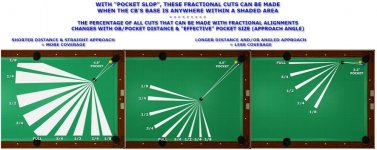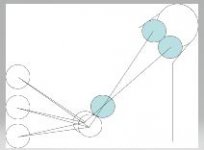Just Aline center to edge, edge to A,B,C,and pivot to center cue ball. Quit over thinking it and just play.
Or, as the OP is showing, just align straight through ccb to where you want the cb to go.
Most players don't need multiple visual lines that lead to a certain ccb (fixed cb), only to then visualize an offset line to that ccb view (1/2 tip left or right) and then pivot to a final ccb. The op is referring to a system that allows you to align straight up with a final ccb (fixed also), a one line visual, the aim line. If you can see this line, or know this line, then you'll be looking straight at the final ccb and it's fixed edges without having to choose A/B/C and then aligning offset to that perspective only to pivot to a different ccb slightly angled from your stance.
To each their own. I prefer the straight forward approach as shown in this thread. I suppose one could use the nearest quarter fraction, look straight down that line through ccb and determine if it'll be a thin or a thick shot, then do an offset pivot from one side or the other of that line to bring the cue into a corrected alignment for the shot. It would take some practice to get the pivot right to make the shot, but every method takes practice. Or, as you say, you can use CTE visuals and then an offset pivot to thin or thicken the line provided by the visuals. But that should be a different thread.


